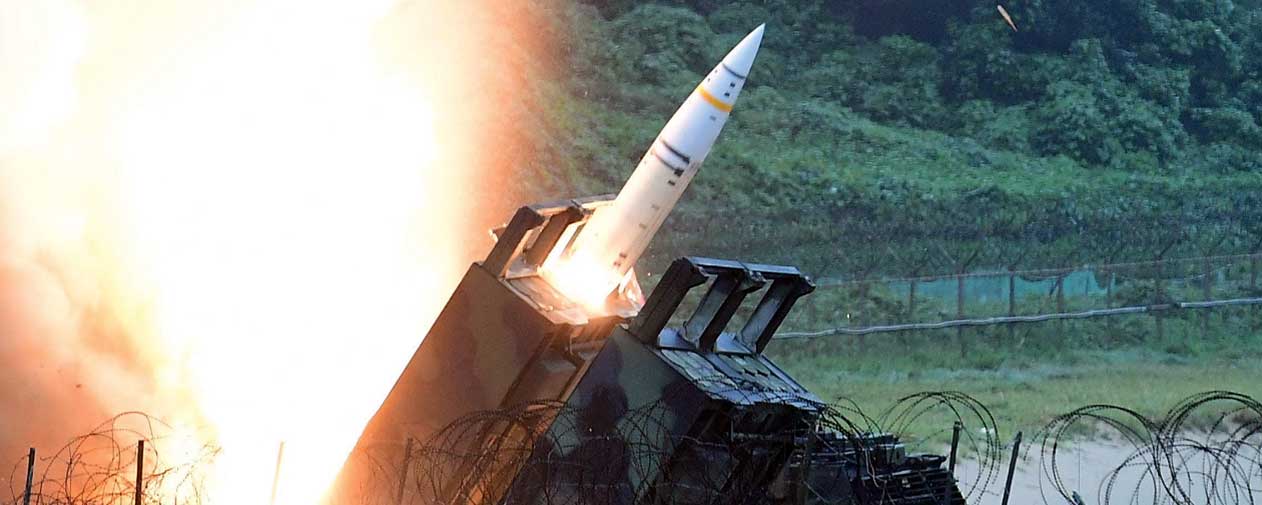
The news has broken that President Joe Biden has given Ukraine “permission” to fire U.S.-made ATACMS missiles deep into Russian territory, and the first attack hit Bryansk on Tuesday.
This escalation of the war is made worse by the fact that the U.S. has to directly provide the training, logistical assistance, and intelligence targeting data for the use of the missiles. This leaves Ukraine, essentially, just pushing the final launch button.
The move brings the U.S. and Russia closer to direct conflict in what has otherwise been a proxy war.
For many months last year, one of the main arguments in Washington against sending ATACMS (Army Tactical Missile System, pronounced “attack-’ems”) to Ukraine was that the level of technology involved in deploying the weapons and getting them to their targets required the expertise of U.S. personnel. The Ukrainians, it was said, lacked the training and intelligence information needed to use the missiles themselves.
There was a fear that this level of direct U.S. action in the war would be viewed as an attack by NATO on Russia. The Biden administration apparently got over that fear, as the ATACMS missiles were approved for use by Ukraine on its territory and in Crimea in late 2023, and now the green light has been given for firing them anywhere in Russia that they can reach.
The White House is engaged in this dangerous escalation because it supposedly wants to step up the fight for democracy in Ukraine before a less-friendly-to-Ukraine Trump administration takes over in 60 days. U.S. peace groups, however, are deeply concerned, and understandably so.
CodePink issued a statement condemning the move by Biden.
“We denounce President Biden’s decision to approve long-range missile strikes – already underway – deep inside Russia. Biden’s reckless decision ignores past Pentagon advice against such long-range strikes, thereby escalating tensions between the two most nuclear-armed nations, the U.S. and Russia, to endanger the entire world.
“In approving these strikes, the Biden White House chose to make the U.S. a direct party to the Ukraine-Russia war, crossing a previous red line and causing Russia to lower the threshold on the use of nuclear weapons.”
The group was referring to the announcement by President Vladimir Putin on Tuesday that his government would now consider an attack against Russia by a non-nuclear power with the “participation or support of a nuclear power” as a “joint attack on the Russian Federation.”
CodePink noted that a settlement to the war “could have been brokered a month after the February 2022 Russian invasion had Western powers not sabotaged the peace deal between Ukraine and Russia.”
Tuesday marked the 1,000th day of fighting since Russian forces crossed the border into Ukraine.
The broader permission to use ATACMS against Russian targets is not the only escalation made by the Biden administration this week. The Associated Press reports that the Pentagon will send Ukraine at least $275 million in new weapons, including an undisclosed number of antipersonnel land mines.
The White House appears to be rushing to do as much as it can in Biden’s final weeks to make things difficult for Russia. The one administration figure who has told the truth, perhaps by mistake, about the U.S. role in the war in Ukraine was Defense Secretary Lloyd Austin, who famously said the goal of the U.S. in Ukraine was to “weaken Russia.”
That goal was long clear, with U.S. support for NATO expansion and the push by U.S. armaments makers and fossil fuel companies to destroy the long-existing policy of peaceful cooperation between Russia and the EU under which Europe purchased energy from Russia, and Russia benefited economically.
Contrary to earlier U.S. accusations, it is now clear that it was not Russia which was behind the blowing up of pipelines that delivered Russian gas to Europe.
The ending of that arrangement caused hardship in Europe and replaced a peaceful relationship with a dangerous pro-war footing. The beneficiaries were the U.S. fossil fuel companies that replaced Russia as the provider of energy to Europe and the U.S. armaments makers that continued a festival of weapons selling.
Meanwhile, Defense Secretary Austin is in the Indo-Pacific region now hammering out deals that allow expansion of U.S. nuclear weapons placement into countries throughout that region. The Korean peninsula and the surrounding area are already saturated with U.S. nuclear submarines prowling the waters, and South Korea has agreed to the placement of these weapons on its territory.
Japan, too, has been cajoled by the U.S. into giving up its official policy of pacifism. Austin is reportedly assuring leaders in the region that there will be continuity between the Biden policies of armaments buildup and those of the incoming Trump administration. Such assurances are of little comfort to pro-peace forces in the U.S. and around the world.
Some of the corporate press is assuring everyone that Putin’s saber-rattling about his country’s alleged readiness to use nuclear weapons is nothing to worry about. The New York Times, as if to encourage the Biden administration’s escalation of the war, says the threats are hollow and that Putin will never act on them.
The implied message is that it’s therefore fine for Biden to escalate the war. The Times expresses no concern, however, for what will be the obvious result of the Biden policy – many thousands of additional deaths on both sides of a war crying out not for escalation but for a negotiated settlement.
Thus far, hundreds of thousands have been killed and millions of lives have been shattered because of decisions like the one that Biden has made to provide ATACMS missiles. “We will continue to provide Ukraine the support it needs to succeed on the battlefield and prevail in its defense against Russia’s aggression,” Secretary of State Antony Blinken said in a statement. Shortly after that, the White House made its land mine announcement.
Also in the new “aid” package will be an infusion of air defense, including munitions for High Mobility Artillery Rocket Systems (HIMARS), as well as 155mm and 105mm artillery rounds, Javelin anti-armor munitions, drones, and other equipment and spare parts.
AP reports that the weapons will be provided through presidential drawdown authority, which allows the Pentagon quickly to pull supplies from its shelves to speed them to Ukraine’s front line.
The Biden administration is now racing headlong to deliver $7.1 billion in weapons from the Pentagon’s stockpiles, aiming to spend all of those funds before Trump is sworn in.
Asked if the department can get that done before Jan. 20, when Trump takes office, Pentagon spokeswoman Sabrina Singh said officials are “working to get Ukraine what it needs.”
In addition to the weapons in the Pentagon drawdown, the State Department told the press Tuesday that it had authorized the sale to Ukraine of $100 million in unspecified defense equipment and services, including vehicle refurbishment, technical assistance, training, and “other related elements of logistics and program support.”
Those “related elements,” although they won’t admit it, would very well cover the costs of using U.S. military personnel to support the latest attacks on Russia.
As with all news analysis and op-ed articles published by People’s World, the views reflected here are those of the author.










